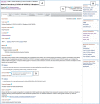The NIH genetic testing registry: a new, centralized database of genetic tests to enable access to comprehensive information and improve transparency
- PMID: 23193275
- PMCID: PMC3531155
- DOI: 10.1093/nar/gks1173
The NIH genetic testing registry: a new, centralized database of genetic tests to enable access to comprehensive information and improve transparency
Abstract
The National Institutes of Health Genetic Testing Registry (GTR; available online at http://www.ncbi.nlm.nih.gov/gtr/) maintains comprehensive information about testing offered worldwide for disorders with a genetic basis. Information is voluntarily submitted by test providers. The database provides details of each test (e.g. its purpose, target populations, methods, what it measures, analytical validity, clinical validity, clinical utility, ordering information) and laboratory (e.g. location, contact information, certifications and licenses). Each test is assigned a stable identifier of the format GTR000000000, which is versioned when the submitter updates information. Data submitted by test providers are integrated with basic information maintained in National Center for Biotechnology Information's databases and presented on the web and through FTP (ftp.ncbi.nih.gov/pub/GTR/_README.html).
Figures

Similar articles
-
Gene: a gene-centered information resource at NCBI.Nucleic Acids Res. 2015 Jan;43(Database issue):D36-42. doi: 10.1093/nar/gku1055. Epub 2014 Oct 29. Nucleic Acids Res. 2015. PMID: 25355515 Free PMC article.
-
ClinVar: public archive of relationships among sequence variation and human phenotype.Nucleic Acids Res. 2014 Jan;42(Database issue):D980-5. doi: 10.1093/nar/gkt1113. Epub 2013 Nov 14. Nucleic Acids Res. 2014. PMID: 24234437 Free PMC article.
-
dbSNP: the NCBI database of genetic variation.Nucleic Acids Res. 2001 Jan 1;29(1):308-11. doi: 10.1093/nar/29.1.308. Nucleic Acids Res. 2001. PMID: 11125122 Free PMC article.
-
Genetic Testing for Developmental Disabilities, Intellectual Disability, and Autism Spectrum Disorder [Internet].Rockville (MD): Agency for Healthcare Research and Quality (US); 2015 Jun. Report No.: 15-EHC024-EF. Rockville (MD): Agency for Healthcare Research and Quality (US); 2015 Jun. Report No.: 15-EHC024-EF. PMID: 26158183 Free Books & Documents. Review.
-
Education resources of the National Center for Biotechnology Information.Brief Bioinform. 2010 Nov;11(6):563-9. doi: 10.1093/bib/bbq022. Epub 2010 Jun 22. Brief Bioinform. 2010. PMID: 20570844 Free PMC article. Review.
Cited by
-
PheNominal: an EHR-integrated web application for structured deep phenotyping at the point of care.BMC Med Inform Decis Mak. 2022 Jul 28;22(Suppl 2):198. doi: 10.1186/s12911-022-01927-1. BMC Med Inform Decis Mak. 2022. PMID: 35902925 Free PMC article.
-
Human gene and disease associations for clinical-genomics and precision medicine research.Clin Transl Med. 2020 Jan;10(1):297-318. doi: 10.1002/ctm2.28. Clin Transl Med. 2020. PMID: 32508008 Free PMC article.
-
Evolving cardiovascular genetic counseling needs in the era of precision medicine.Front Cardiovasc Med. 2023 Jun 23;10:1161029. doi: 10.3389/fcvm.2023.1161029. eCollection 2023. Front Cardiovasc Med. 2023. PMID: 37424912 Free PMC article.
-
The 2013 Nucleic Acids Research Database Issue and the online molecular biology database collection.Nucleic Acids Res. 2013 Jan;41(Database issue):D1-7. doi: 10.1093/nar/gks1297. Epub 2012 Nov 30. Nucleic Acids Res. 2013. PMID: 23203983 Free PMC article.
-
Supporting interoperability of genetic data with LOINC.J Am Med Inform Assoc. 2015 May;22(3):621-7. doi: 10.1093/jamia/ocu012. Epub 2015 Feb 5. J Am Med Inform Assoc. 2015. PMID: 25656513 Free PMC article.
References
Publication types
MeSH terms
Grants and funding
LinkOut - more resources
Full Text Sources
Other Literature Sources
Medical

